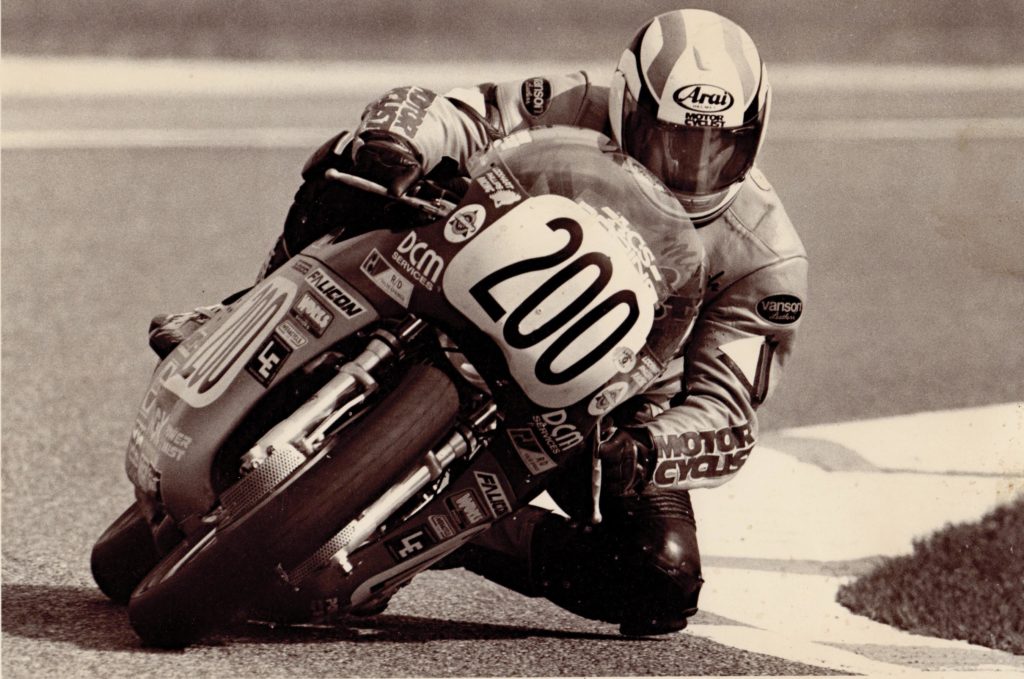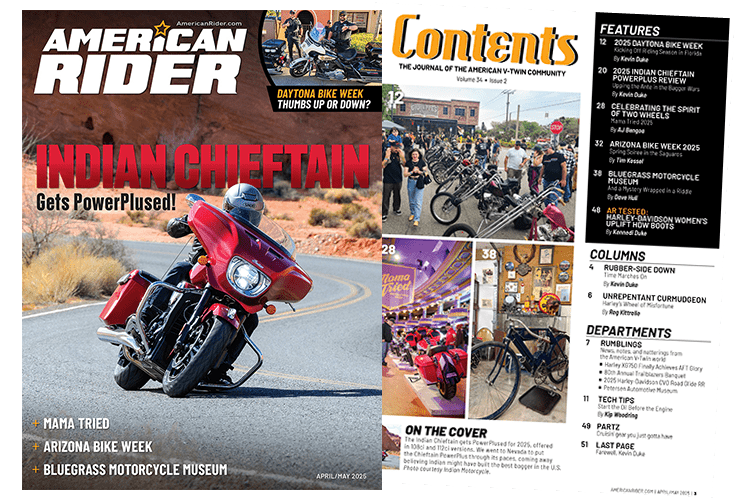If you’re down there, getting pelted by pea gravel at the outside of turn one at Lima, or standing inside the back-straight fence gap at Dixie Speedway, or watching from the exit of turn four at Williams Grove, or standing against the Armco on the inside of turn one at Sacto or Springfield or the Meadowlands, you simply can’t believe what you’re seeing.
The awe and spectacle of it hits me fresh every time I’m at an AFT flat track National – and I’ve been to a few lately. All eighteen last season, in fact, and a few this year, too.
It’s much more than the thunderous, staccato noise and the literal shaking of the ground when the bikes roar by. There’s also a raw and visceral violence in the way the riders – sometimes in packs of three, four or five – flick their bikes into the corners at 100 mph, going from full throttle to off throttle as weight transfers to the front wheel and the rear tire steps out to slow and help turn the motorcycle.
It’s a violent and beautiful thing to witness, and it just might be the most riveting and purely elemental man-and-machine (or woman-and-machine) duo in the motorsports world.
Now, I have done a lot of motorcycle racing since I first threw a leg over that Honda Mini Trail back in about 1970. I’ve raced motocross since 1974 and road raced since 1984, have about a billion testing and evaluation laps between my years at Motorcyclist and Cycle World and American Honda, and have watched many of the world’s best racers – Roberts, Lawson, Spencer, Rainey, DeCoster, Ward, Hannah, etc. – up close and personal at places like Laguna Seca, Silverstone, Daytona, Mid-Ohio, Glen Helen, Lexington and Unadilla.

But as amazing as those riders are, nothing I’ve seen in my nearly 50 years of motorcycling is as mind-blowing as watching a 100-horsepower dirt tracker being thrown into a 100-mph corner with Airfence-lined Armco barrier and straw bales lurking menacingly just 50 feet away. It’s like trying to describe a Grateful Dead show to someone who’s never been; you just have to experience it.
And trust me… you owe it to yourself to experience it.
Despite my magazine and industry work from the mid ’80s onward I never delved too deeply into the professional dirt track scene. I became good friends with the legendary Ricky Graham during his early ’90s championship run and covered a lot of AMA Nationals at Ascot and Sacramento and Daytona and Pomona over the years. But my sweet spots remained road racing and motocross, and for the most part the dirt track paddock was a mystery to me.
All that changed a bit when I took a Communications Director job with American Flat Track in late 2017. Except for old-timers like Johnny Goad and Bill Werner (and Chris Carr, who was AFT’s Chief Competition Office at the time), most of the riders and crews had morphed generationally since the heady days of the ’80s and ’90s, but the sense of community and family that has always permeated the dirt track world was there in force, from riders to crews to family members. Most of these folks have known each other and raced against each other for years, and for the most part they look after one another. There’s community in pro road racing and motocross, too, but in flat track it’s palatable and strong, and uniquely personal.
There’s deep history, too, from the Wrecking Crews of the early years, to the BSA/Triumph vs. Harley-Davidson fights of the ’60s and ’70s, to the Roberts years (anyone not know of Kenny’s epic run at Indy in 1975 on the TZ750 two-stroke?), to the epic Harley-Davidson/Honda duels of the 1980s with guys like Jay Springsteen, Steve Morehead, Bubba Shobert, Graham, Scotty Parker and our own Mr. Carr.
Deservingly, professional dirt track racing is undergoing a rebirth. A simpler class structure, better promotion, live-streaming on FansChoice.tv and a TV deal with NBCSN – which telecasts slickly produced one-hour features a week after each race (check americanflattrack.com for the telecast schedule) – is helping spread the dirt track gospel to a wider mainstream and enthusiast audience, which is helping attract new sponsors and money to riders, teams and the series itself. Harley-Davidson and Indian Motorcycle are prime players, as you’d expect, but the last year has seen the likes of Honda, KTM and Red Bull getting involved, all of which is good news for the sport and its future.
As I write this there are just two races left in the schedule, the September 21 Minnesota Mile and the September 28 Meadowlands Mile at the legendary New Jersey Meadowlands, just a few miles from Manhattan. That Meadowlands finale will be happening just about the time this issue gets into readers’ hands, but you can watch live on FansChoice.tv or catch the NBCSN feature telecast on October 12 (premier, 10:30 pm ET) and 16 (re-air, 1:00 pm ET). The Minnesota Mile telecasts can be seen on September 29 (premier, 7:30 pm ET) and 30 (re-air, 4:00 pm ET).
Next season, do yourself a favor and catch a race or two of what’s arguably the greatest show on dirt. Whether you get pelted with pea gravel at Lima or watch the guys pitch it into turn one on the inside of Sacto’s or Springfield’s or the Meadowlands’ turn one, you’ll be very glad you did.
Nuthin’ like it anywhere.
If you dare to go toe-to-toe with Boehm find him at longstrangetrip@thunderpress.net. May your wounds quickly heal.


















